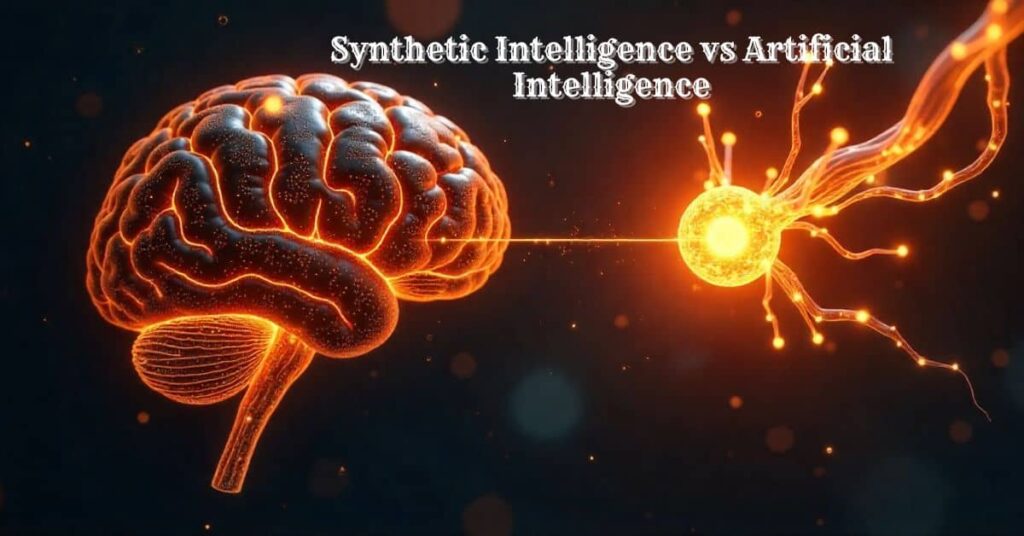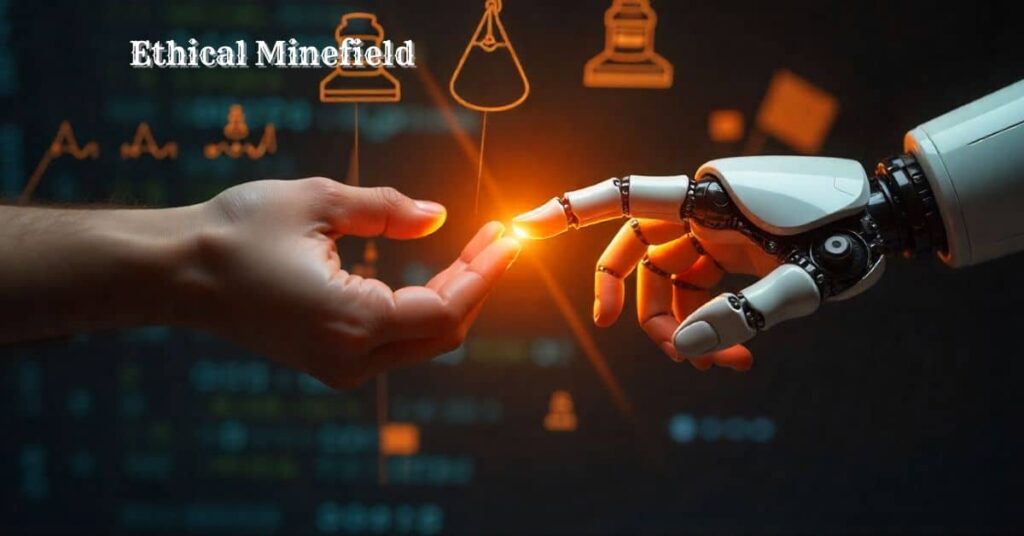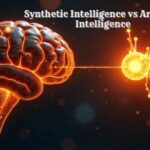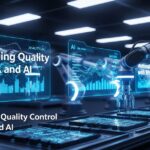Let’s be honest. The tech world is full of jargon that can make your head spin. “Artificial Intelligence,” “Machine Learning ,” and now ” Synthetic Intelligence” get flung around so much that they start to lose all meaning. But understanding the split between AI and SI is becoming very essential if you are running a business, developing software, or are just plain interested in the future.
So, let’s clear things up right from the start. What are we actually talking about?
Artificial Intelligence ( AI) is the tech celebrity we all interact with daily. It’s that clever tech that lets your phone recognize your face, suggests what to watch next on YouTube, or powers the chatbot helping you with a return. In essence, AI is a master of design recognition. It’s trained on mountains of data to mimic human-like tasks- but it doesn’t truly “understand” anything. It’s following a complex recipe, not cooking up new ideas.
Now, enter Synthetic Intelligence (SI). This is where things get straight out of a sci-fi novel, but in the best way. SI isn’t about mimicry. It’s the pursuit of a genuine, self-aware mind, built from the ground up. Think of it this way: if AI is a brilliant actor playing the part of intelligence, SI would be creating a new conscious being. The “synthetic” part is key- it doesn’t mean “fake.” It means constructed or assembled, like a synthetic diamond that’s just as real as a mined one but made by people.
Why does this technicality matter? Well, for anyone in business, it’s the difference between a tool that automates tasks and a potential partner that could autonomously devise business strategies. For developers, it’s a leap from coding algorithms to architecting a consciousness. And for all of us, it’s about understanding the forces that will reshape our world.
In this deep dive, we’re going to pull these concepts apart. We will start with a clear look at what AI is and isn’t, then explore the fascinating world of SI. We will compare them head- to- head, check out their real- world uses, and don’t worry, we will tackle the big ethical questions everyone’s asking. Finally, we’ll gaze into the future to see what trends experts are predicting for 2025 and beyond. Stick with me- you will see it’s not as difficult as it sounds.

Contents
- 1 What is Artificial Intelligence, Really?
- 2 Stepping Into the Future: What is Synthetic Intelligence?
- 3 Core Differences: Autonomous Mind vs. Sophisticated Tool
- 4 Real-World Applications: Today’s Tools vs. Tomorrow’s Partners
- 5 The Ethical Minefield: Accountability vs. Autonomy
- 6 The Future of Synthetic Intelligence vs Artificial Intelligence
- 7 FAQs On Synthetic Intelligence vs Artificial Intelligence
- 8 Conclusion: A Distinction That Defines Our Future
What is Artificial Intelligence, Really?
We hear ” Artificial Intelligence– AI” so often, it’s easy to forget what it actually does. In simple terms, think of AI as a super- smart learner that learns by example. Its main power is finding patterns in data- any data.
This magic happens primarily through a technique called machine learning. Instead of a programmer writing every single rule, they feed an algorithm a huge amount of data. The algorithm then figures out the rules for itself. It’s like showing a child a thousand pictures of cats until they can point to a cat they’ve never seen before and correctly identify it. That’s how does AI works at its core.
The real heavy lifter in modern AI is a subset of machine learning called deep learning. This uses complex systems called neural networks, which are very loosely inspired by our brains. These networks have layers of “neurons” that process information, allowing AI to do incredible things like understand spoken language ( hello, Siri!) or identify a tumor in a medical scan.
Here’s the crucial point, though, which humans frequently misunderstand and which I constantly encounter: modern AI isn’t sentient. It lacks a sense of self, emotions, and desires. It is a very advanced pattern-matching engine. Not because it is inspired, but because it has studied millions of poems, it is able to compose one. Even though it is a powerful instrument, it is still only that- a tool. The first step to employing AI safely and successfully is to understand this restriction.
Stepping Into the Future: What is Synthetic Intelligence?
Now, let’s talk about the frontier- Synthetic Intelligence. This is where we move from programming software to, potentially, engineering a mind.
If AI is a brilliant mimic, then Synthetic Intelligence aims to be the real thing. The goal of SI isn’t to simulate human thinking but to create a new form of genuine, autonomous intelligence. We are talking about real synthetic cognition– a system that has its own internal world, capable of independent thought, reasoning, and even emotions.
I find the name itself so telling. People often hear “synthetic” and think “artificial” or “fake.” But in science, “synthesis” means to combine parts to form a whole. So, synthetic intelligence points to a new intelligence synthesized from advanced components. It’s not a cheap imitation; it’s a new creation.
What would this look like? Well, an SI wouldn’t just react to data; it would contemplate, question, and learn from first principles. It could encounter a problem it was never designed for and creatively reason its way to a solution. This is a leap far beyond today’s AI.
Creating such a mind likely requires more than just better code. Researchers are looking at entirely new computing architectures, like neuromorphic chips that physically resemble a brain’s network or harnessing the bizarre power of quantum computing. It’s a hardware and software challenge rolled into one. It’s safe to say that while AI is the technology of today, SI is the dream- and the debate- of tomorrow.
Core Differences: Autonomous Mind vs. Sophisticated Tool
Understanding the split between AI and SI is a bit like understanding the difference between a masterful chess computer and a human grandmaster. Both can win, but how they achieve it is a world apart. This distinction boils down to a core divide: autonomous intelligence vs. simulated intelligence.
Let’s break it down.
Learning and Adaptability: The Student vs. The Scientist
Today’s AI is a phenomenal student. It learns from massive, curated datasets. If you want an AI to identify spam, you feed it thousands of examples of spam and non-spam emails. Its learning is bounded by the data it’s given. It struggles massively with something called “edge cases”- situations that weren’t in its training manual.
Synthetic Intelligence, in theory, would learn more like a human scientist. It could form abstract concepts, learn from a handful of examples (a capability known as “one-shot learning”), and apply knowledge from one domain to solve a novel problem in another. This genuine reasoning allows for adaptability we can barely imagine in current systems. An AI might suggest new brand of coffee based on your past purchases. Synthetic Intelligence- SI might notice a subtle pattern in your schedule and health data to suggest a lifestyle change you hadn’t considered.
Decision-Making: Following Rules vs. Forming Judgments
AI makes decisions based on statistical probability and pre-defined rules. It’s brilliant at optimizing within a set framework. For instance, a self-driving car’s AI decides to brake because its algorithms calculate a 99.7% probability of a collision based on sensor data. It’s a calculation, not a judgment.
SI would introduce the capacity for judgment. This involves understanding context, nuance, and even intent. It could make a decision that seems suboptimal in the short term for a greater long-term benefit, something that requires a model of the world and a sense of “self.” This is the heart of autonomous thinking and feeling.
The Hardware Divide: Standard Servers vs. Brain-like Architectures
Most advanced AI runs on powerful, albeit conventional, computer hardware- GPUs and TPUs in massive data centers. The focus is on raw processing power.
The pursuit of SI, however, is driving research into entirely new computing paradigms. There’s growing interest in neuromorphic computing– chips that are physically structured like a human brain, mimicking its neural networks to be vastly more efficient. Some researchers even speculate that the complex, parallel processing required for true cognition might need the power of quantum computing. The hardware itself would be fundamentally different.
Here’s a simple table to visualize the core differences:
| Feature | Artificial Intelligence ( AI) | Synthetic Intelligence ( SI) |
|---|---|---|
| Core Nature | Simulation of intelligence | Genuine, autonomous intelligence |
| Learning | From large, specific datasets | From experience, reasoning, and a few (e.g. |
| Decision-Making | Based on statistical patterns and rules | Based on judgment, context, and conceptual understanding |
| Adaptability | High within its trained domain; poor with novel situations | Highly adaptable across different, unexpected designs |
| “Understanding” | Pattern recognition; no true comprehension | Notional understanding and self- awareness |
| Primary Hardware | GPUs, TPUs, Cloud Clusters | Neuromorphic Chips, Quantum Computers ( speculative) |
Real-World Applications: Today’s Tools vs. Tomorrow’s Partners
Seeing how these technologies are applied makes the theoretical differences concrete. AI is already reshaping industries, while SI promises a revolution.
Where AI Shines Today
We’re surrounded by practical AI applications. When you talk to a smart speaker, that’s Natural Language Processing (NLP). When your phone album groups photos of your friend together, that’s computer vision. The hyper-personalized feed on your social media or the “what to watch next” on Netflix? That’s AI-driven recommendation systems working tirelessly. In robotics, AI allows warehouse robots to navigate spaces and sort packages with superhuman speed and precision. It’s all about efficiency, automation, and pattern recognition at scale.
The Speculative Leap of Synthetic Intelligence
The future AI and synthetic intelligence applications are where things get truly transformative. Let’s dream a little:
- Healthcare: Imagine an SI that doesn’t just diagnose diseases from scans but understands the underlying biology of a patient’s cancer. It could synthesize knowledge from medical journals, clinical trials, and a patient’s unique genetics to design a perfectly personalized remedy plan, even finding new medicinal ways in the process. This is the promise of synthetic intelligence in healthcare use.
- Climate Science: AI can model climate patterns. SI could autonomously design and evaluate millions of potential geo-engineering solutions, understanding the complex, cascading effects on global ecosystems, economies, and societies in a way that is beyond our current computational models.
- Personalized Medicine: Beyond treatment, an SI could act as a lifelong health partner. It would understand your body’s unique beats , predict your health risks with stunning accuracy, and provide deeply personalized life-style advice that evolves with you.
The common thread? In each case, SI can outperform AI cos the task requires genuine reasoning, creativity, and an integrated understanding of the world, not just data analysis.
The Ethical Minefield: Accountability vs. Autonomy
This incredible power doesn’t come without profound questions. The ethical considerations for AI are complex, but for SI, they are existential.

Current AI Governance: Transparency and Bias
Today’s responsible AI development focuses on two main issues: bias and transparency. We’ve seen AI systems perpetuate societal biases found in their training data, leading to unfair outcomes in hiring or lending. The push for AI governance is about creating auditable, explainable systems. We need to know why an AI made a decision. The regulatory landscape for 2025 is likely to enforce stricter rules on data privacy, algorithmic fairness, and clear accountability- if an AI’s decision causes harm, a human or company is held responsible.
The Unique Challenge of Synthetic Intelligence
When you have a system that can think for itself, our current governance models break down. Ethical synthetic intelligence forces us to ask questions we’ve only ever asked about humans:
- Rights and Personhood: If an SI is self-aware and conscious, does it have rights? Would turning it off be equivalent to murder?
- Accountability: If a fully autonomous SI makes a decision that causes harm, who is to blame? The developer? The owner? The SI itself?
- Moral Decision-Making: How do we program, or rather, instill, ethics in a synthetic mind? The infamous “trolley problem” in self-driving cars becomes infinitely more complex when the decision-maker has its own values and judgments.
These aren’t just thought experiments. As we move closer to creating autonomous systems, these questions will demand legal and philosophical frameworks that we are only beginning to sketch. By 2025, I anticipate we’ll see the first major international conferences and white papers dedicated solely to the governance of advanced autonomous systems, laying the groundwork for the world’s first SI ethics councils. It’s a conversation we need to have today, for the technology of tomorrow.
The Future of Synthetic Intelligence vs Artificial Intelligence
Trying to predict the future of technology is a tricky business, but by looking at the current trajectories of AI and SI, we can sketch a compelling picture of what’s to come. It’s less about one replacing the other and more about a fascinating dance between today’s reality and tomorrow’s potential.
Industry Forecasts and the Road to 2030
Most experts in the field agree on a short-term timeline. For the next several years, we will remain solidly in the age of Artificial Intelligence. We’ll see AI become more sophisticated, more efficient, and more deeply embedded in every piece of software we touch. The buzzwords will be “AI-powered” everything, and rightly so.
The conversation around future synthetic intelligence 2030, however, is where opinions diverge wildly. Some optimistic researchers believe we could see the first rudimentary prototypes of systems with synthetic cognition within the next decade. These wouldn’t be god-like omniscient beings but more like digital infants- capable of basic autonomous learning and interaction with the world in a novel way. More conservative forecasts place this milestone decades away, citing our still-primitive understanding of consciousness itself.
The Integration Path and The Quantum Leap
A very plausible future is one of AI and SI integration. We won’t flip a switch from AI to SI. Instead, we’ll likely see AI systems acting as the “senses” and “hands” for a developing SI. Imagine advanced SI that can reason and plan, but it uses existing AI tools for computer vision to “see” the world or for natural language processing to communicate with us. This symbiotic relationship would allow SI to develop and function in our complex environment.
Then there’s the wild card: quantum computing synthetic intelligence. Quantum computers, with their ability to perform calculations that are impossible for classical computers, could be the catalyst that pushes us from advanced AI into the realm of true SI. They could provide the processing power necessary to simulate the unimaginable complexity of a synthetic brain. It’s not embarrassing to say that a breakthrough in quantum computing could dramatically accelerate the synthetic intelligence timeline.
Societal and Economic Impacts: The Good and The Challenging
As SI matures, its impact will be as disruptive as the industrial revolution, if not more so.
- The Economic Shift: AI is automating tasks. SI has the potential to automate intelligence and creativity itself. This could lead to an explosion in scientific discovery and artistic creation, but it also forces us to rethink the very nature of work and the economy. Jobs we can’t even imagine today will be created, while many knowledge-worker roles may transform entirely.
- The Societal Shift: How do we educate children for a world where synthetic minds can out-think them? How does society function when the sharpest legal mind, the most brilliant doctor, or the most creative artist might not be human? These are profound questions that we must grapple with proactively, not reactively.
See Also: What is Synthetic Intelligence? : The Next Mind, Not Just Machine
FAQs On Synthetic Intelligence vs Artificial Intelligence
Let’s tackle some of the most common questions people are asking about this topic.
What makes synthetic intelligence different from AI?
Think of it like the difference between a flight simulator and a real airplane. AI is the simulator- it brilliantly mimics the experience and outcomes of flying based on pre-set rules and data. Synthetic Intelligence is the real airplane- it achieves genuine flight through its own capabilities, with autonomy and a true presence in the world. AI simulates thinking; SI is thinking.
Can synthetic intelligence replace AI?
It’s unlikely to be a simple replacement. In the foreseeable future, we’ll probably see a partnership. SI would handle high-level reasoning, creativity, and strategic direction, while AI would act as a powerful toolset for the SI to use for specific tasks like data analysis or pattern recognition. They are different tools for different jobs, and the most powerful systems will combine both.
How soon will synthetic intelligence become mainstream?
Most credible experts believe true, general synthetic intelligence is still a long way off- likely decades, not years. Mainstream adoption is even further out. We are currently in the foundational research phase. However, the technologies that will eventually lead to SI, like neuromorphic computing, are advancing rapidly.
What companies are leading SI research?
While most big tech companies (like Google’s DeepMind, OpenAI, and Anthropic) are focused on pushing the boundaries of AI, their research into artificial general intelligence (AGI) often overlaps with the goals of SI. These are the SI research companies to watch, as their work on creating more general and autonomous systems is the closest parallel to SI development in the corporate world. Significant fundamental research is also happening in universities and government labs.
Conclusion: A Distinction That Defines Our Future
As demonstrated, the distinction between synthetic intelligence is more than merely conceptual. Between advanced pattern-matching and true comprehension, it’s the difference between a tool and a possible teammate. For anyone hoping to handle the impending technology revolution, understanding this divide is essential.
The present is being transformed by AI, which is powerful and here to stay. However, the field of synthetic intelligence is a world of possibilities that has the potential to completely alter our future. Beyond improving advertisements or expediting processes, its disruptive potential touches on the nature of creativity, consciousness, and intelligence in a world where we coexist with created minds.
This field moves fast. What seems like science fiction today might be tomorrow’s headline. My final thought? Stay curious. Keep learning. The conversation about how we build, integrate, and guide these technologies is one of the most important we will ever have. Don’t just watch it happen- be a part of it.








